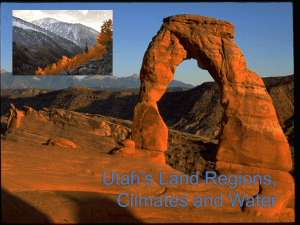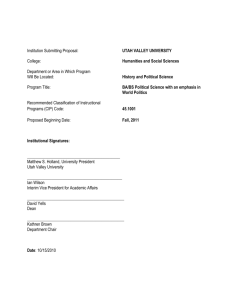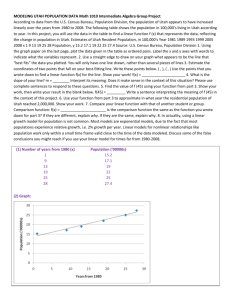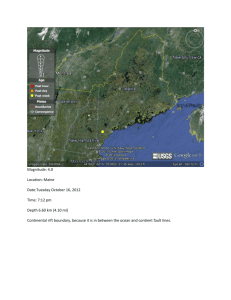File
advertisement
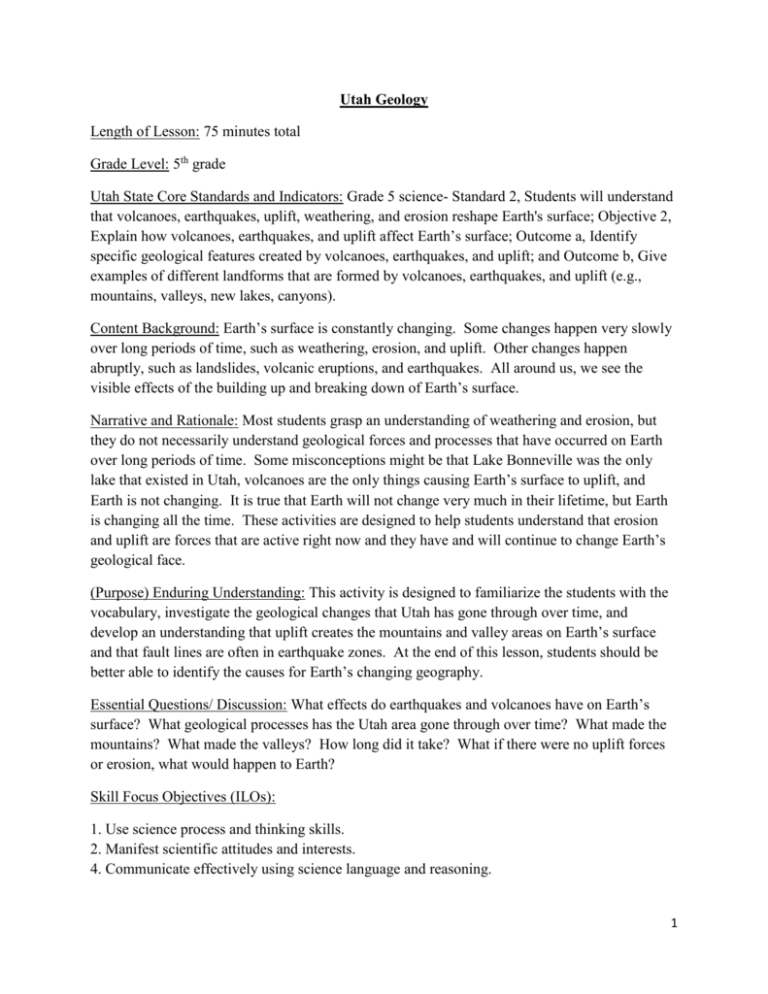
Utah Geology Length of Lesson: 75 minutes total Grade Level: 5th grade Utah State Core Standards and Indicators: Grade 5 science- Standard 2, Students will understand that volcanoes, earthquakes, uplift, weathering, and erosion reshape Earth's surface; Objective 2, Explain how volcanoes, earthquakes, and uplift affect Earth’s surface; Outcome a, Identify specific geological features created by volcanoes, earthquakes, and uplift; and Outcome b, Give examples of different landforms that are formed by volcanoes, earthquakes, and uplift (e.g., mountains, valleys, new lakes, canyons). Content Background: Earth’s surface is constantly changing. Some changes happen very slowly over long periods of time, such as weathering, erosion, and uplift. Other changes happen abruptly, such as landslides, volcanic eruptions, and earthquakes. All around us, we see the visible effects of the building up and breaking down of Earth’s surface. Narrative and Rationale: Most students grasp an understanding of weathering and erosion, but they do not necessarily understand geological forces and processes that have occurred on Earth over long periods of time. Some misconceptions might be that Lake Bonneville was the only lake that existed in Utah, volcanoes are the only things causing Earth’s surface to uplift, and Earth is not changing. It is true that Earth will not change very much in their lifetime, but Earth is changing all the time. These activities are designed to help students understand that erosion and uplift are forces that are active right now and they have and will continue to change Earth’s geological face. (Purpose) Enduring Understanding: This activity is designed to familiarize the students with the vocabulary, investigate the geological changes that Utah has gone through over time, and develop an understanding that uplift creates the mountains and valley areas on Earth’s surface and that fault lines are often in earthquake zones. At the end of this lesson, students should be better able to identify the causes for Earth’s changing geography. Essential Questions/ Discussion: What effects do earthquakes and volcanoes have on Earth’s surface? What geological processes has the Utah area gone through over time? What made the mountains? What made the valleys? How long did it take? What if there were no uplift forces or erosion, what would happen to Earth? Skill Focus Objectives (ILOs): 1. Use science process and thinking skills. 2. Manifest scientific attitudes and interests. 4. Communicate effectively using science language and reasoning. 1 Vocabulary Focus: Uplift, earthquake, volcano, fault, erosion, weathering, geological. Preparation/ Materials: Utah: A Geologic History - images of Utah through time, pdf Public Information Series #54 http://www.ugs.utah.gov/utahgeo/geo/index.htm#geohist Fault Blocks Fault Blocks Continued ABC Fault Blocks Wasatch Fault Figure Scissors Glue Topographical map of Utah Computer lab with access to a word processing program Teacher-created blog for student discussions (easy instructions for creating a blog can be found at https://www.blogger.com/start, if needed) Engage/ Launch: (10 minutes) “Have you ever wondered why some places have mountains and valleys, while other areas of the world are flat plains? How do you think these landmarks were formed?” Encourage the students to think about the topic on hand. As a whole class, conduct a KWL chart on the board to find out what the students already know, and what topics interest them. Discuss what makes a good, researchable question. Support the students in generating questions to explore throughout the lesson. Management: Ask students to clear their desks, prior to the discussion. Make sure there is nothing in front of them to distract their attention. Use a favored attention-getting device to ensure all students are engaged in the discussion. Explore: (20 minutes) Show the class the Utah topographical map. Have students come up and point out geological features they can see. Invite students to explore how mountains and valleys are created through the use of fault blocks. Explain the procedures required to put the blocks together (cut out the blocks, fold on lines, glue on tabs, et.), then pass out the materials for students to complete the task. Hand out the ABC Fault Block page to the students and allow them to follow the procedures explained there. Circulate around the room and offer help to students if they need it. Ask guiding questions to further student comprehension of fault involvement in land formations. Develop the idea that A and C moving away from each other create mountains (A, C) and the B area would become a valley. Then move A and C together. Help students understand that uplift would occur (B area). Show Wasatch Front figure. Ask questions to correlate how the figure 2 and the fault blocks are similar. (Students should discover that where the mountains and valley meet there is a fault line.) Encourage students to use the appropriate vocabulary in their discussions. Management: Explain class expectations for completing the investigation before passing out supplies. Have one student from each table grab the scissors and glue required for their group. During the exploration, be available for student inquiries and keep them on task. Move from table to table to get a better sense of student understanding. Once students have completed the 15 minute exploration, move on to the next phase. Explain/ Summarize: (35 minutes) Pull the class back together for a review of what has been discovered. Ask the students what conclusions they have formed. If unanswered questions arise, encourage the students to think about the question quietly, then turn to a partner and discuss their hypothesis. Remind students of the questions that were generated in the beginning of the lesson. Ask them to keep in mind questions that have not been explained. After this short review, move to the computer lab for an explanation of the material covered. Share with the class Utah: A Geologic History - images of Utah through time on the internet. This site shows the progression of Utah’s geography over a long period of time throughout history. Help students to come to the understanding that Earth’s surface can be affected immediately, such as in the case of a landslide, volcanic eruption, or earthquake where a fault line is the cause; or it can happen very gradually over time such as through weathering, erosion, and uplift. Explain to the students how these natural disasters occur. Discuss different geological features that can result in these instances. Once students have a good understanding of what causes these geological changes, ask the students to submit at least two questions relating to the topic of Earth’s changing surface on a blog. Students may work individually, or in a pair. Encourage students to ask challenging, open-ended questions that take some thought to answer. Once everyone has submitted questions, have the students try to answer at least one question someone else wrote. Encourage students to discuss back and forth the questions and possible answers. As a teacher, you need to place a high value on interactive discussion and brainstorming. Help the students to think through the questions scientifically, and to give thoughtful answers in response. Management: Explain to the students what will take place in the computer lab before moving them. Set expectations for quiet walking in the halls and staying on task. Remind students that this is a scientific community, and all ideas are valued. Encourage students to respect each other’s ideas and questions. Elaborate/ Extend/ Apply: (10 minutes) Ask the students what else they want to know about Earth’s surface that has not been covered. Encourage students to consider how they could find the answers to their questions. Invite the 3 students to learn about the hazards of earthquakes in Utah, e.g., liquefaction. What do they think liquefaction means? Does anyone want to research it and present their findings to the class? Invite students to investigate a topic of interest and be prepared to share with the class what they have found. They will be given time in class to visit the library and/or computer lab to aid in their research. Students could also learn what to do during an earthquake at home and other places. Another activity might be to look through a Utah Travel guide and find places in Utah that have unique geology. Encourage the students to find something that interests them and explore that topic. Management: Bring students down to the carpet for a less formal discussion. Let the students throw their own ideas around. Encourage scientific thinking and creativity. Allow for student inquiry. Reinforce the scientific community and respect all ideas presented. Ask students to raise their hands so everyone is not talking over each other. Evaluate/ Assessment: Review what has been discussed about Earth’s changing surface today. Ask students to relate things they have learned that they didn’t know before. Ask the students to reflect in their journals on the big idea question: “What geological processes has the Utah area gone through over time?” What made the mountains? What made the valleys? How long did it take? etc. Supply students with time in the computer lab to write a short essay that addresses these questions. Look for students using appropriate terminology in their writing, such as uplift, earthquake, volcano, fault, erosion, weathering, geological, etc. 4


